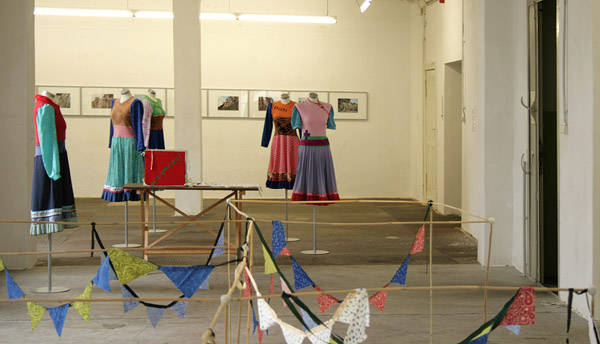The exhibition EXTREME CRAFTS took place at Freies Museum, Berlin, Postdamer Str. 91. Åsa Sonjasdotter's Potato Perspective on Crossings, Ideas and Matter in Prinzessinnengarten, Moritzplatz Berlin, Prinzenstr. 35 – 38/ Prinzesinnenstr.
4. – 31. August 2012
Curators: Ulrike Solbrig, Jole Wilcke, Hilde Methi
download press relase: german english
EXTREME CRAFTS brings together current approaches in art that deal with the ethical and aesthetic dimension of craft and its potency as an idea in art. We want to highlight different ways to bring art and craft together to produce "a productive confusion within the normal hierarchy of cultural prestige" (Thomas Crow).
With the subject craft recently gaining considerable attention within the Scandinavian and English speaking art context, EXTREME CRAFTS will be the first thematic group show in Berlin that looks specifically at craft within the context of conceptual and participative art approaches. EXTREME CRAFTS gathers new productions as well as existing works from artists who have dealt with the subject craft over an extended period and who are using craft to look at and get involved with broader societal issues. Artists will take on diverse roles: observers, mediators, craftspeople, do-it-yourself initiators, activists and documentarians.
Craft is one of the categories used to mark the border between art and non-art. In a hierarchy of cultural prestige craft is usually considered less than art. Modernism greeted industrial production as the relief from monotonous craft practice. In contemporary discourse "craft" is regarded as a more sustainable empowering means of production, where "head and hand still work together".

Partners: The Sami Art Festival 2008 – 2011/The Sami Artists' Union
Supported by:

Credits
Notices:
The views expressed on this site are the authors' own.
The Norwegian artist-duo Ingrid Book & Carina Hedén approach reality by means of documentation, inviting political and ethical questions of a more general nature. In their photo series Soldiers UXO-Clearance, 1-7 (2005) soldiers are observed cleaning a military training area in Norway from ammunition. While their ’characters’ are trying to erase an artificial element, Book and Hedén actually increase it, making explicit references to nineteenth-century realism with all it’s pathos and pictorial force. In their photo series, Produced Landscapes 1-45" 2009-2012, they show road cuttings i.e. blasted rock faces along the new highway between Sweden and Norway taken from a car in motion. The encounter between a slow geological process and a fleeting perception.
Charlotte Nilsen makes new clothes from old and used ones. Playful and elegant dresses resemble the traditional Samicostume, but she offers it as a distributive D-I-Y recipe and an ‘open-source’ alternative. The ‘multiplicity model’ resists the standard of how to make and who can wear the costume, while commenting on the politics of ethno-/national cultural symbolism as well as on the fashion industry.
The artist Suwan Laimanee in 1996 declared his craft Thai Massage to be his art, when he massaged the visitors of the Biennale di Firenze over the whole 4-month exhibition period.
From August 13th – 17th you are invited to take part in his workshop at Freies Museum to learn this ancient craft and Become a Thai Masseur Within One Week.
YNKB invites everybody to join the Repair workshop, to bring things they want to have repaired to locals with a special skill for repairing and thereby find creative solutions. In addition, they present Waste Service Tea Bar, recycled porcelain painting workshop, where Instant Herlev Institute will teach everybody to paint their own Waste Service pattern dinnerware.
Yvette Brackman collaborates with Sami artisans from Lovozero, who manufacture their shoes in a traditional fashion from the leather of their reindeer herds. This collaboration resulted in LUJA – partly an enterprise as a sculpture, partly a model of distribution and production of the LUJA crafts. She will also be presenting a new sculpture titled Article 6 that meditates on the significance of textiles in the Canandaigua Treaty of 1784 between the US government and the Iroquois Confederacy and how this relationship is upheld today.
The film The right to the land and the water by Geir Tore Holm is based on interviews with people who are affected by the Finnmark Act by which ‘the Sami have collectively and individually acquired rights to land’. The various viewpoints are voiced by one man who is out logging – traditional knowledge meets formalized opinions on land use.
Åsa Sonjasdotter will, with the support of the artist Nicolas Woche, contribute with a reflection on Politics in Breeding/ Breeding in Politics including a presentation of the The Prinzessinnengarten Potato Breeding Project that is carried out in collaboration with gardener Matze Wilkens and many volunteers at the Prinzessinnengärten in Kreuzberg.
Ulrike Solbrig together with the help of Niels Rieckert from Allmende Kontor built a community garden in the court yard of Freies Museum together with prospective gardeners, Field Works gives with their science fiction video KRYSTALLERNES HÆVN [The Revenge of the Crystals] (2012) critical insights into the everyday life of a community garden in a post-revolutionary, post-capitalist future.
Elke Mohr and Ingeborg Lockemann invite Cüneyt Varol to exhibit his models of ships, which he created at a program sponsored by the employment office. Cüneyt Varol, who would actually like to work as a gardener, built the objects exhibited here with found materials. Kristinn G. Harðarson acts just as playful in his work around (1996), in which he reenacts simple moments of every day life on a miniature stage, transferring child play into the world of grownups directing attention to the craft of child-play.
Since 1997 the international art association SCHMUCK2, established by artist Susan Pietzsch, situated in the northern German province of Mecklenburg, has served as an interface for international art projects between art and applied art, with special emphasis on new jewelry. At Freies Museum Schmuck2 will feature students’ work focusing upon the bizarre connection between cars, jewelry and human nature, developed during a workshop in the jewelry department 'Het Sierraad' at the Gerrit Rietveld Academie in Amsterdam.
